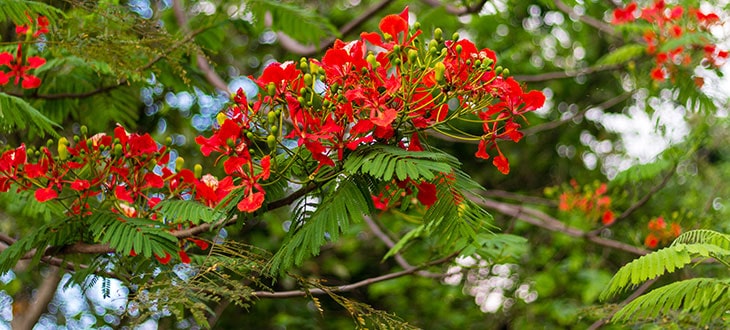7 Trees With Fern-Like Leaves
Did you find an unknown tree with fern-like leaves and need help identifying it? Below is a list of several tree species which have leaves similar to those of ferns.
Ferns are popular perennial decorative plants due to their leaves’ wild look and especially because they grow where many plants won’t grow – in full shade.
Over 10,000 different species of ferns are known, and many of them can be recognized quickly by the design of their leaves (fern leaves are usually called “fronds“). The leaves are basically composed of which appear to be many smaller leaves, arranged on a central leaf stalk. The size, shape, and complexity of the leaves can vary greatly from one species of fern to another.
Many species of ferns grow close to the ground, but there are also some that grow in the same way as trees, with leaves that grow above the ground level on a trunk.
In this article, we are not going to talk about the tree ferns, but about other shrubs and tree species that have fern-like leaves but which are not actually ferns.
Contents
1. Jacaranda (Jacaranda Mimosifolia)

Jacaranda mimosifolia is a species of flowering tree native to South America. It is also known as the fern tree, blue jacaranda, purple panic, black poui, or the exam tree.
These trees are very common in countries like Argentina, Brazil, or Bolivia, but have become fairly common in many other countries with warm climates. The popularity of Jacaranda trees is mainly due to their lovely violet flowers that emerge in spring and early summer, and which can last for up to two months.
In addition to their flowers, these trees attract with their exotic-looking foliage. Specifically, Jacaranda mimosifolia has leaves similar to some species of ferns.
Jacaranda mimosifolia is mainly used as an ornamental tree and it is very commonly planted on the roadsides. However, due to the fact that these trees grow fast, in proper conditions adding up to 120 inches (3 m) a year in their early stages, and because they can out-compete the native species, they have been included in the list of invasive species in parts of South Africa and Australia.
2. Royal Poinciana (Delonix regia)
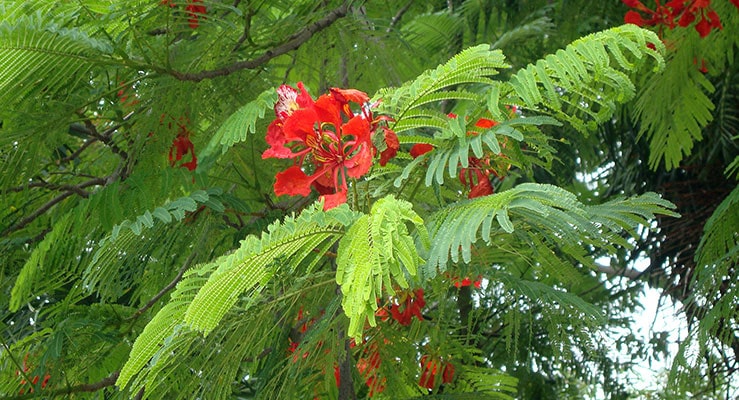
Delonix regia is a tree species indigenous to Madagascar. Some of the most common names of this tree include royal poinciana, flamboyant tree, flame tree, or flame of the forest.
Although it is endangered in the wild, many specimens are still widely cultivated as ornamental trees, thus saving this species from extinction. Delonix regia is evergreen in many climates but sheds its leaves in regions that have mildly cool winters or elongated drought periods.
Typically, an adult tree can reach up to a height of roughly 40 ft (12 m). They develop a generous crown with dense foliage. This is also the reason why Delonix regia is often used as a tree for shading and often planted near the areas where animals graze.
These shrubs have green, fern-like leaves and produce an abundance of orange to red flowers. There is, however, a verity called “flavida” whose flowers are yellow. Their flowering period may differ from one climate to another.
3. Japanese Fern Tree (Filicium Decipiens)

Filicium Decipiens is a small to medium-sized ornamental species of trees with dense foliage and fern-like leaves of a bright-green color.
Although many know these shrubs as “Japanese fern trees,” they are neither ferns, nor they are indigenous to Japan. These trees actually have their origins in regions of East Africa and South Asia.
Japanese fern trees are in great demand in landscaping activities because they do not require much care. They also have dense foliage with an exotic look and a crown that naturally maintains a relatively round and eye-pleasing shape, without requiring periodic pruning as in the case of other species of ornamental shrubs.
These trees are usually grown for their foliage, but they do produce flowers once a year. The blooms are small, white, and grow in loose clusters. Eventually, these will turn into some tiny, purple, inedible berries. These fruits will leave stains on the pavers and sidewalks around the trees after they drop, so many may find that a bit annoying.
4. Velvet Mesquite Tree (Prosopis Velutina)
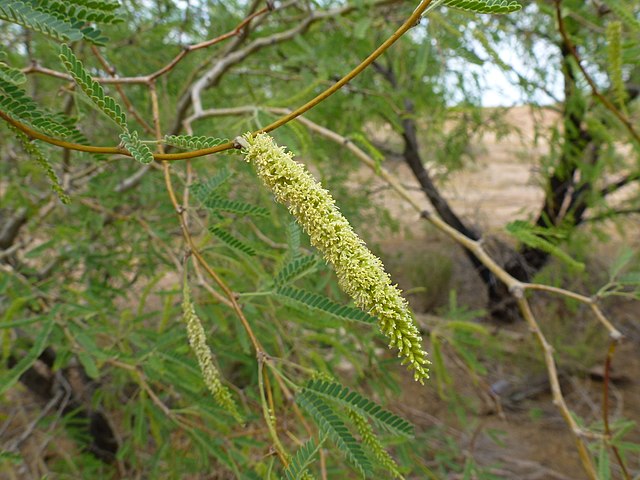
Prosopis velutina is a small to medium-sized species of trees that grow in arid climates. It is popularly known as the velvet mesquite and is native to the deserts in North America.
Although they are considered potentially invasive and dangerous plants for local crops when grow outside their natural habitat and are classified as noxious weeds in several regions, these trees play an important role in their native ecosystems.
Prosopis velutina normally grows up to 30 to 50 ft (9–15 m) tall, has deep roots, and thorns at the base of the small branches. These trees can also be easily recognized by their fern-like leaves, with elongated stems and oval compound leaflets, covered with fine hairs.
In spring, the velvet mesquite trees produce yellow flowers that grow in dense cylindrical clusters. These later turn into long seed pods and provide a food source for several species of animals. Animals also help the spreading of the seeds.
5. Fern-Leaved Wattle (Acacia Filicifolia)
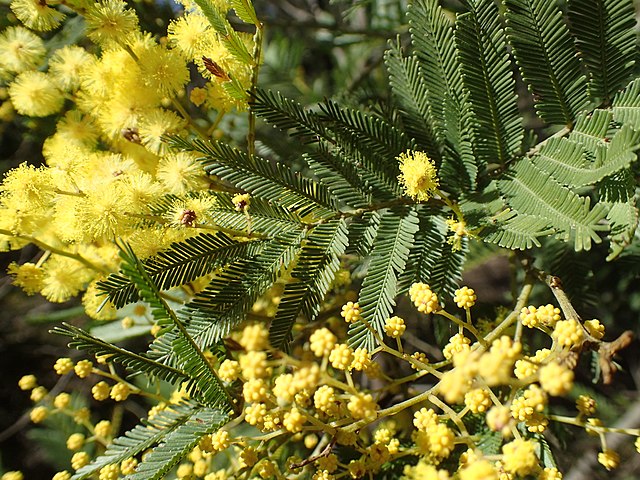
Acacia filicifolia is another species of tree that seems related to ferns. It is commonly known as the fern-leaved wattle and is typically found growing on the roadsides on the coasts and tablelands of New South Wales, Australia.
Shrubs of this species usually reach a maximum height between 10 and 50 ft (3–14 m). The structure of their branches is very similar to that of ferns, with long bipinnate leaves. From July to October, these trees produce yellow flowers which later develop into dark brown pods.
The fern-leaved wattle is a fast growing tree but which has a relatively short lifespan of about 25 years.
6. The Honey Locust (Gleditsia Triacanthos)

Gleditsia triacanthos is a species of tree indigenous to central North America, but because of its adaptability, it has been introduced to many places around the globe. It is commonly known as the honey locust, thorny honeylocust, or thorny locust. Its name derives from the sweet taste of the pulp of their pods (legumes), which are consumed by livestock and wildlife.
The trees in this species can reach a height of 66 to 98 ft (20–30 m) and have a medium-to-long life span. In optimum conditions, honey locusts can live up to 120 years.
Gleditsia triacanthos are common ornamental trees in many parts of the world. They are also exceptional shading trees due to their dense foliage. Other advantages include fast growth, adaptability to many types of soils, high drought tolerance, and quick recovery after transplanting.
Honey locust branches present dense clusters of thorns which act as a defense system against herbivores. They have fern-like leaves with bright-green leaflets, bipinnately on young trees and pinnately compound on older specimens.
Although these trees provide food for some species of animals, due to their rapid spread and accelerated growth, they are also seen as invasive species in many parts of the world.
7. Copperpod (Peltophorum pterocarpum)
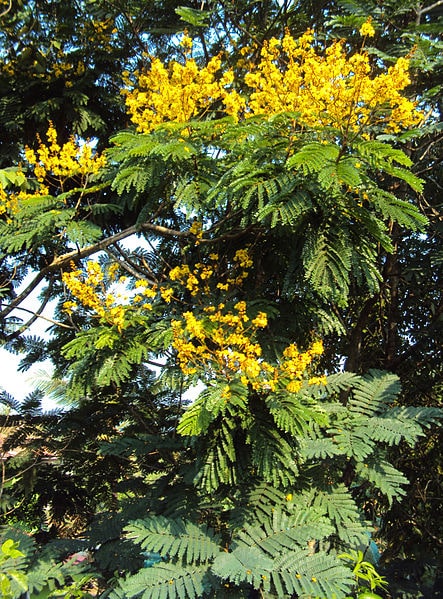
Peltophorum pterocarpum is a tree native to tropical southeastern Asia. Some of the most common names for these trees include copperpod, yellow flametree, yellow-flamboyant, yellow-flame, or yellow poinciana.
Peltophorum pterocarpum typically grows no more than 65-82 feet (20-25 m), but in isolated cases, it can grow double that size. Like many trees with fern-like leaves, Peltophorum pterocarpum has bipinnate leaves, each with 20 to 40 oval leaflets. It produces yellow flowers, which later turn into red pods that ultimately become black when ripe.
These trees are often used as decorative shrubs due to their foliage resembling that of ferns and the charm of their yellow flowers.
Final Word
These are several species of trees whose leaves resemble the foliage of ferns. There are countless other plants that may have leaves that look similar to ferns’ fronds but are not true ferns.
You may also be interested in our article titled “5 Fern-like Weeds.”

